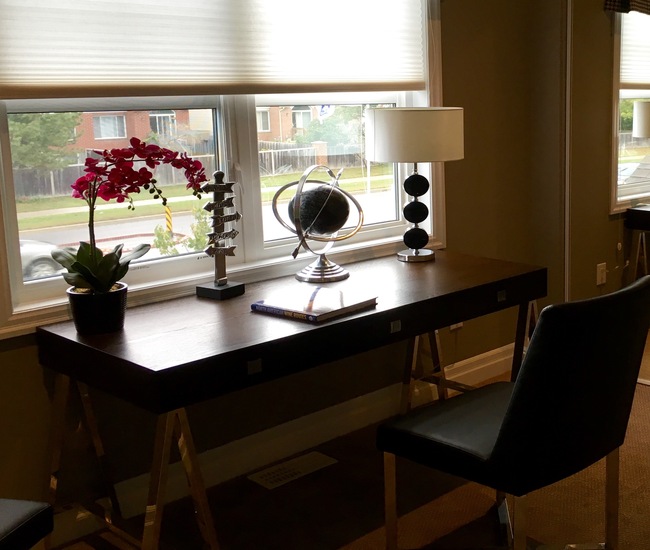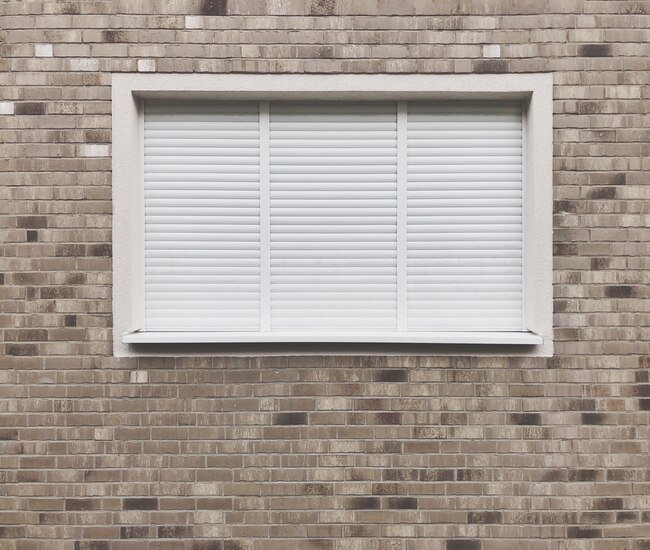Deciding between real wood and faux wood blinds for your home in 2025? Here’s all you need to know before taking a final decision. Get expert insights into the pros and cons of real wood and faux wood blinds to help make the perfect choice for your home’s aesthetic, functionality, and budget.
Both real wood and faux wood blinds have pros and cons, so it’s important to know what you are looking for. However, both types give a traditional, natural wooden look to your windows.
This post explores the respective advantages and disadvantages of real and synthetic wood blinds from different angles. Here you’ll also discover how each type looks in the room, how to clean them, and why some people prefer faux wood blinds over the real thing.
When it comes to cost, real wood blinds cost a pretty penny, while faux wood blind are so affordable. There are other advantages to faux wood blinds, too. The faux wood type is moisture resistant, easily to clean, and comes in lots of colors.
Scroll on to find out which type – real wood or faux wood – is worth the money. And you can read about how they look in rooms and how to clean them easily.
Real Wood vs Faux Wood Blinds – a Comparative Analysis

Consider the look, durability, cost, aesthetic, and style options to make an informed decision when choosing between real wood and faux wood blinds. When deciding between these two popular types of window coverings, you should also consider the room you’re designing and the size of its windows.
Cost Comparison – Real Wood Blinds are More Expensive

The price of real wood blinds starts from $242 and goes beyond $1,000 for larger windows. On the other hand, you can get a best quality 2” Faux Wood Blind for as low as $42. In other words, you can cover five windows with faux wood blinds at the price of a single genuine wood blind.
If you’re in the market for new blinds for your home but don’t want to compromise on looks and spend too much, we highly recommend faux wood blinds.
However, when it comes to durability, real wood blinds are a better option than vinyl or composite options. While real wood blinds are more expensive, they are far more durable and are an excellent choice if your windows face a harsh climate and they are frequently opened and closed.
The only drawback to real wood blinds is their price.
Natural Warmth & Longevity
Real wood blinds can be a great investment for your home if you want it to add class and warmth to your decor. Also, real wood blinds have a longer lifespan and are a great investment for new homes.
Color Choices for Real Wood vs Faux Wood Blinds

Faux wood blinds are available in 100’s of colors, while real wood blinds come with fewer color choices. Their limited color range means natural wood window treatments may not suit every home. Nevertheless, it is best to select real wood blinds if you have wooden furniture in your room, such as wooden dining tables and bookshelves.
If you’re considering adding faux wood blinds to your home, you’ll have lots of options to match your decor. Whether you’re looking for a timeless look or modern appeal, Faux Wood Blinds are a fantastic way to enhance your room’s decor. Choose solid colors to match your home’s existing color scheme, or select embossed wood grains for an authentic 3D look.
To match your existing colors, Faux Wood Blinds come in an array of shades, textures, and wood grain imitations. Traditional wood blinds have two-inch slats, leaving about a two-inch gap when fully opened. Larger slats, on the other hand, are proportionate to the window and offer a better view when opened. If you’re not sure about the best option for your home, you can request a free sample to find out which one will best fit your home.
To add an elegant finishing touch to your home decor, consider adding a cloth tape to the faux wood blinds. Available in various colors, they add a touch of decorative flair and can cover route holes, which can be a strangulation hazard for small children or pets. You can also purchase custom-cut faux wood blinds to coordinate with your existing décor. You can even choose to combine several faux wood blinds in one room to create a seamless look.
Resistance to Cracking & Warping
Extended periods of direct sunlight and heat will cause synthetic wood blinds to warp and crack. On the other hand, real wood blinds come from forests and go through a three-step drying process to prevent cracking and warping. They also retain the distinctive characteristics of North American hardwoods, including their fine graining and beautiful texture. Most real wood blinds are made from North American hardwoods, utilizing sustainable forestry practices. These blinds require special care and should never be cleaned with harsh chemicals.
Cordless Option for Kid- & Child-Safety

You can get both natural and synthetic types with a cordless option if you have young children and pets in your home.
Look – Natural Paint and Stain vs Imitated Appearance
Compared to faux-wood blinds, real wood blinds tend to give a more natural and rich look to your home. They are grainy in texture and look great with natural paint and stain. This style of window coverings can give your home an elegant, warm look.
While real wood blinds are naturally beautiful, some aren’t. Faux wood blinds are made of composite material and are stained to resemble natural wood.
While faux wood blinds are less expensive than genuine wood blinds, they will likely look cheap compared to their real-wood counterparts. So, if you want to avoid the added expense of custom-made wood blinds, faux wood blinds may be a good choice.
Resistance to Humidity
Generally, faux wood blinds stand up better to humid conditions than genuine wood blinds.
Size of Window

Faux wood blinds are best suited for medium-sized windows, so they won’t look good on very large windows.
Ease of Opening/Closing
Real wood blinds are typically much lighter than their faux counterparts, making them easier to open and close.
Despite these differences, real wood window blinds are a beautiful choice for a variety of home decor schemes.
Factors to Consider When Deciding between Real Wood and Faux Wood Blinds
When deciding between real and faux wood blinds, there are many factors to consider, including:
Durability
Genuine wood options are more durable.
Resistance to Extreme Temperatures

Real wood blinds withstand heat better. They also help regulate temperature and are a practical choice for warmer climates.
Look
Natural wood blinds add more beauty, sophistication, and warmth to your decor. Real wood blinds provide a sleeker, airier, and more luxurious interior look. They are a great choice for homeowners who want to add a touch of class to their home. On the other hand, faux wood blinds are a less expensive option to mimic the look of real wood blinds.
Insulation

Real wood blinds absorb heat and cold more effectively than faux wood blinds and provide better insulation.
How to Clean Real and Faux Wood Blinds

Faux wood blinds are generally easier to clean than real wood blinds. Real wood blinds tend to accumulate dirt in corners, so it is essential to get them all cleaned. If you find that your blinds have accumulated too much dirt, you can use a damp rag to clean them.
Often, faux wood blinds come with an anti-static feature to prevent excessive dust from collecting. The anti-static feature will reduce your need for feather dusters and help you save money on cleaning supplies. If you plan to keep your blinds for a long time, choose those with 100% UV protection.
Cleaning faux wood blinds is easy. Use a microfiber cloth or feather duster to dust the blinds every now and then. Alternatively, you can use a vacuum attachment and a soft cloth dipped in soapy water to remove dirt. If you want to remove more dust, you can also apply a dryer sheet to prevent further buildup. And, don’t forget to dry the blinds thoroughly.
You can also apply a cleansing agent to remove stains. Before using any product to clean your real or faux wood blinds, dust them thoroughly with a duster or dry cloth. Dusting them with a duster is an easy way to clean them without damaging the slats. Alternatively, you can use a solution of white vinegar and lukewarm water to disinfect them.
How to Install Real Wood & Faux Wood Blinds

Being heavier than real wood blinds, faux wood blinds are generally challenging to install.
Faux wood blinds are often made of low-quality materials. To avoid damaging them, always install them by following certain instructions. Once you’ve learned the steps, you can start putting them up by yourself. If you don’t know how to install them, hire a professional.
Here are DIY steps to install real wood or faux wood blinds:
- Measure window size differently depending on the mounting location. Also measure depth for an inside mount.
- Secure mounting brackets to the wall or window frame with screws.
- Hang the blinds.
Faux wood blinds can be installed by a homeowner with a bit of experience. Installing cheap faux wood blinds is easy enough and doesn’t take much time. Installing cordless real or faux wood blinds requires a screwdriver, or a drill bit with a 1/4-inch Hex head.
Despite the easy installation process, you have to be careful when working with electric tools and drilling holes. To avoid the possibility of accidents, wear safety glasses and work carefully.
Conclusion
Summing up, if you can afford a more durable option, go with real wood blinds. If you are tight on budget, you can find a great option in the form of faux wood blinds. Not only are they affordable and incredibly durable, but they can easily match other types of wood blinds. Both real and faux wood blinds come with several upgrade options. If you want to add a traditional, warm look to your home, faux wood blinds are an affordable option. They will last for many years without regular conditioning, which is great for busy families with small children or pets.
FAQs
What are the disadvantages of faux wood blinds?
- Faux wood blinds may not have the same natural beauty and texture as natural or genuine wood blinds.
- Blinds made of synthetic wood are hard to customize, as they are mass-produced using molds and templates.
- Faux wood blinds are heavier than their real wood counterparts, making installation challenging.
- Even the best quality faux wood blinds cannot completely mimic the sophistication of real wood.
Are wood or faux wood blinds more expensive?
Genuine wood blinds are typically more expensive than their faux wood counterparts. While a real wood blind would cost over $240 per piece for a small window, you can easily get a faux wood window covering for just around $42 for a 24” W x 36” H window – what a huge difference! However, faux wood blinds don’t give the same richness that you’d get from high-end genuine wood blinds. And wood blinds do have disadvantages. For example, the embossed wood grain will collect more dirt and dust, making the slats more difficult to clean.
Do faux wood blinds last?
Durable faux wood blinds made of composite PVC can last for several years (sometimes up to 25 years!) if properly cared for. Typically they last 5 to 8 years. To avoid discoloration, select blinds that are UV safe.
The exact lifespan of faux wood blinds will depend on several factors:
- Type and quality of material – PVC blinds are more durable and hard-wearing than vinyl ones.
- Protective coating – faux wood blind coated with UV-resistant material will last longer.
- Exposure to heat and humidity – blinds exposed to harsher direct heat and more humidity will have a shorter lifespan.
- Cleaning – keeping your faux wood blinds clean will add to their lifespan.
Do faux wood blinds warp in the sun?
While genuine wood blinds withstand direct sunlight and heat better, faux wood blinds will easily warp due to exposure to high levels of direct heat in certain predictable scenarios. PVC composite blinds painted with heat absorbing colors, such as dark gray and brown, have the higher possibility of warping in very hot areas such as south-facing windows and conservatories.
Need More Help?
Still unable to decide between real wood and faux wood blinds for your home? Get in touch for free consultation! Use 24/7 live chat or give us a call at (800) 863-6109 to contact our experts for DIY window treatment solutions.
